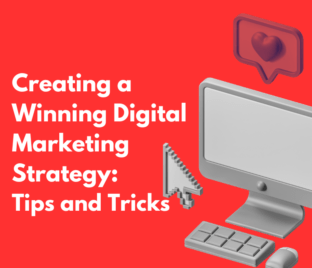ELEMENTS, TECHNIQUES, AND BEST PRACTICES
In today’s fast-paced digital world, capturing and maintaining the attention of your audience is essential for any business looking to establish a strong online presence. Visual storytelling is a powerful tool that can help businesses convey their messages in a compelling and engaging manner.
This article will delve into the concept of visual storytelling, covering its essential elements, techniques, and best practices to help companies effectively communicate their stories to their target audience.
Understanding Visual Storytelling
Visual storytelling is the art of conveying a narrative or message through visual elements such as images, videos, infographics, and other graphical content. This approach is highly effective because our brains are naturally wired to process visual information more quickly and retain it better than text alone. When combined with a compelling story, visuals can evoke emotions, drive engagement, and leave a lasting impression on the viewer.
Key Elements of Visual Storytelling
1. Story Structure:
A well-structured story is fundamental to effective visual storytelling. It generally follows a three-part structure:
Beginning: Introduce the audience to the characters, setting, and context of the story. This phase sets the stage and provides the necessary background for the narrative.
Middle: Present a conflict, challenge, or a turning point that engages the audience and creates tension, curiosity, or excitement. It’s the core of the story where characters face obstacles or dilemmas.
End: Offer a resolution to the conflict, providing closure and satisfying the audience’s curiosity. It’s the point where loose ends are tied up, and the story’s message or lesson is often revealed.
2. Emotional Connection:
Emotional connection is pivotal in visual storytelling as it allows the audience to relate to the content on a deeper level. Here’s how it can be achieved:
Relatable Characters: Develop characters that the audience can empathize with, making the story more engaging and emotionally impactful.
Compelling Narratives: Craft a narrative that elicits emotions such as joy, sadness, excitement, or surprise. A well-structured story with a compelling plot can evoke emotional responses.
Evocative Imagery: Use visuals that evoke specific emotions or reactions. Colors, facial expressions, and imagery can all trigger emotional responses.
3. Consistency:
Consistency in visual elements is vital for a cohesive and recognizable brand identity. This ensures that the audience can easily associate visuals with your brand:
Colours: Use a consistent colour palette that aligns with your brand’s identity. Colors evoke emotions and help in brand recognition.
Fonts: Stick to a specific set of fonts that complement your brand and maintain readability across various platforms.
Design Style: Adopt a consistent design style, whether it’s minimalistic, bold, or intricate. This creates a unified and professional appearance.
4. Simplicity:
Keeping the story and visuals simple is crucial to ensure that the audience can quickly grasp the message without feeling overwhelmed:
Clarity: Present information and visuals in a clear and straightforward manner, avoiding unnecessary complexity or jargon.
Focus: Keep the main message or plot in focus, avoiding distractions that may dilute the impact of the story.
Visual Hierarchy: Arrange visuals in a way that guides the audience’s attention to the most important elements of the story.
5. Call to Action (CTA):
Incorporate a clear and compelling call to action to guide the audience on what steps to take next after engaging with the visual story:
Clarity: Make the CTA clear and specific, clearly stating what action you want the audience to take.
Relevance: Ensure the CTA aligns with the content of the story and provides value to the audience.
Urgency: Use language that encourages immediate action, creating a sense of urgency.
By integrating these key elements into your visual storytelling strategy, you can create engaging, relatable, and memorable stories that resonate with your audience and drive desired actions.
Techniques for Effective Visual Storytelling
Use Compelling Images and Graphics:
High-quality visuals capture attention and convey messages more effectively than plain text. The key is to align visuals with your story and brand. For instance:
Example: Imagine a fitness brand using vibrant, energetic images of people working out, conveying a message of an active and healthy lifestyle.
2. Employ Videos and Animation:
Videos and animations offer a dynamic way to tell a story. They can effectively showcase products, share testimonials, or provide behind-the-scenes glimpses. Here’s an example:
Example: A tech company might create an animated video showcasing the evolution of its product, illustrating its features and benefits in an engaging manner.
3. Infographics and Data Visualization:
Infographics and visualizations simplify complex information, making it more engaging and memorable for the audience. For example:
Example: A nonprofit organization working on environmental issues might create an infographic illustrating the impact of plastic pollution on marine life, using clear visuals and statistics.
4. Interactive Content:
Interactive elements encourage audience participation and engagement. Incorporate elements like quizzes, polls, or clickable images within your visual storytelling. Here’s an example:
Example: A news website might include a clickable map allowing users to explore election results interactively, engaging them in the data.
5. Storyboarding and Sequencing:
Planning the sequence of visuals in a story, similar to a storyboard, ensures a logical flow that guides the audience through the narrative. For instance:
Example: An advertising campaign for a car manufacturer would carefully sequence visuals, starting with sleek shots of the car, followed by its features, and finally showcasing the driving experience.
By utilizing these techniques and incorporating relevant examples, you can enhance your visual storytelling strategy and create compelling, engaging stories that resonate with your audience effectively.
Best Practices for Mastering Visual Storytelling
1. Know Your Audience:
Understanding your target audience is crucial because it enables you to tailor your visual storytelling to resonate effectively with them. This involves:
Researching Preferences and Interests: Conduct research to understand what types of visuals, themes, or narratives your audience is drawn to.
Analyzing Behaviours: Study how your audience interacts with different types of visual content and what keeps them engaged.
Segmentation: Divide your audience into segments based on demographics, behaviors, or preferences to create targeted visual stories for each segment.
Example: A fashion brand targeting young adults might use vibrant and trendy visuals on platforms like Instagram, aligning with the preferences of their youthful audience.
2. Tell an Authentic Story:
Authenticity in storytelling is crucial for building trust and credibility with your audience. This involves:
Aligning with Brand Values: Ensure that the stories you tell are consistent with your brand’s mission, values, and principles.
Sharing Real Experiences: Incorporate genuine experiences, testimonials, or real-life stories that demonstrate your brand’s authenticity and reliability.
Example: A sustainable fashion brand might share the journey of a local artisan, highlighting their commitment to ethical and eco-friendly practices.
3. Test and Iterate:
Continuous testing and iteration are vital for refining your visual storytelling strategy and understanding what works best for your audience. This involves:
A/B Testing: Experiment with different visual elements, narratives, or layouts to determine which versions are more effective in engaging your audience.
Gathering Feedback: Actively seek feedback from your audience and use their insights to improve and refine your visual storytelling approach.
Example: An e-commerce platform may A/B test product images, comparing different angles or backgrounds to determine what entices users to make a purchase.
4. Mobile Optimization:
Given the significant portion of internet traffic coming from mobile users, optimizing visuals for mobile devices is essential. This involves:
Responsive Design: Ensure that visuals adapt seamlessly to various screen sizes and resolutions.
Fast Loading Speed: Optimize image and video sizes to minimize loading times on mobile devices, improving user experience.
Example: An online news platform ensures that its visuals and videos are appropriately sized and load quickly on mobile devices, providing a smooth browsing experience for mobile users.
5. Incorporate Storytelling into Branding:
Integrating visual storytelling into your overall branding strategy helps create a cohesive brand narrative. This involves:
Consistent Messaging: Ensure that the stories you tell align with the overall brand message and reinforce brand values consistently.
Unified Visual Style: Maintain a cohesive visual style that reflects your brand’s identity across all platforms and materials.
Example: A tech company incorporates consistent visual elements, color schemes, and narratives in its advertisements, website, and social media, reinforcing its brand identity and message.
By implementing these best practices, businesses can enhance their visual storytelling efforts, effectively engage their target audience, and create a lasting impact that aligns with their brand values and objectives.
Conclusion
In conclusion, mastering the art of visual storytelling involves understanding the key elements, employing effective techniques, and following best practices. By creating engaging and emotionally resonant visual stories, businesses can capture their audience’s attention, convey their messages effectively, and ultimately drive desired actions.




